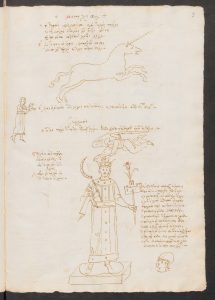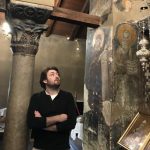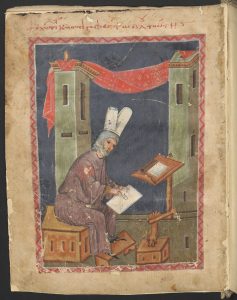φθοράν τε παθεῖν κινδυνεύουσαν, φίλε,
ὡς μηκέτ’ εἶναι μὴ δὲ κεκλῆσθαι βίβλον·
τῇ συνδετικῇ τεχνίτου χειρουργίᾳ,
(5) τέχνης τε λοιπῆς ποικίλῃ τεχνουργίᾳ,
ὁ ποιμενάρχης Αἰνιτῶν συνδεῖ πάλιν
καὶ τὴν πρὶν εὐπρέπειαν αὐτῇ παρέχει·
ὡς ἀναγινώσκοιτο πᾶσι ῥαδίως.
and in danger of suffering destruction, my friend,
so that it would no longer be a book nor be called so,
with a craftsman’s binding art
(5) and the manifold handicraft of the rest of the crafts,
the chief shepherd of Ainos binds it again
and provides it with its former beauty
so that it might be read easily by everyone.
Some elements of this poem are common to other book epigrams. For example, the formula τὴν παροῦσαν πυκτίδα shows many parallels in the DBBE (and the number increases if we consider all the records including variants of ἡ παροῦσα πυκτίς/βίβλος/δέλτος or τὸ παρὸν πυκτίον/βιβλίον/πυξίον). The bishop of Ainos evidently plays the role of the patron, who had the book rebound, so the verb συνδεῖ in verse 6 should be understood as causative, as usual in patron-related book epigrams. The reference to the readers of the book in verse 8 is also found in many reader-related epigrams in DBBE. However, the nature of the work sponsored by the bishop of Ainos, which is described in verses 4-6, is more exceptional in book epigrams. The rebinding of the book does not find many parallels in the DBBE. The tag “Damage of the book”, for example, includes only one relevant parallel, Type 6072 with its Occurrence 23590, in which the process of rebinding is described (verse 12) and the restorer is put on the same level as the patron of the manuscript when the reader is asked to pray for their salvation (verses 19-24).[2]
Another remarkable feature of this epigram is the mention of Ainos in verse 6. A number of verse scholia in this manuscript show striking parallels with the work of Ephraim of Ainos, who composed a verse chronicle in the first quarter of the 14th century rewriting the account of Niketas Choniates and other historians. We knew already that Ephraim of Ainos had used a manuscript from the tradition of the shorter version of Niketas Choniates’ History, to which ÖNB, Hist. gr. 53 belongs.[3] I have argued elsewhere that the verse scholia represent a first approach of Ephraim to his source and that these versified reading-notes were later revised by Ephraim and incorporated in his chronicle.[4] However, the verse scholia are found in other manuscripts from the shorter version, whereas the book epigram that mentions the city of Ainos is exclusive to ÖNB, Hist. gr. 53.
A last remarkable feature of our book epigram can help to explain the situation. The epigram is copied on the verso of a piece of parchment attached to the end of an otherwise paper manuscript (image 2). How did this happen? Why was the epigram not copied on the paper flyleaf (f. 323)? Is this piece of parchment a remnant of the manuscript before the restoration or a remnant of the materials used in the restoration? The material support of our book epigram invites us to think that it could have belonged to another manuscript: the parchment could be a piece of the (now lost) manuscript where the verse scholia were originally copied by Ephraim. When ÖNB, Hist. gr. 53 was copied from this manuscript, the piece of parchment might have been cut out from the exemplar and pasted onto the apographon.

The second book epigram that I would like to discuss is found on f. 168v of Vatican City, Biblioteca Apostolica Vaticana, Vat. gr. 163 (Diktyon 66794). The poem addresses emperor Andronikos I Komnenos and condemns the assassination of Alexios II Komnenos, the legitimate heir of the throne, which granted Andronikos the empire. The poem is copied in red by the same hand that copied the main text of Niketas Choniates’ History, right after the end of the second (and last) book of Andronikos’ reign and before the beginning of the first book of Isaak II Angelos:[5]
ἀνθ’ ὧν ἄωρον ἐξέτιλας τὸν στάχυν
τὸν Ἀλέξιον τὸν γλυκὺν μειρακίσκον,
Ἀνδρόνικε φεῦ, τὸν βασίλειον τόκον,
(5) ὃν λαγόνες γῆς τῆς βασιλίδος Ξένης
ὑπανέδωκαν ὡς ἄριστα γηπόνῳ
τῷ βασιλεῖ Μανουὴλ καὶ φυτοσπόρῳ,
ὅστις ἔλαχεν ἐν βασιλεῦσι κλέος.
for having plucked the unripe head of grain,
the sweet child Alexios,
-alas, Andronikos!- the royal offspring,
(5) whom the womb of the earth, queen Xene,
offered like the best fruits to the husbandman
and sower, to king Manuel,
who received glory among kings.
The layout of the book epigram in Vat. gr. 163 continues the disposition in three columns of two other poems of 8 verses each that are part of the text of the History and surround our book epigram (image 3). Niketas Choniates frequently quotes from the so-called oracles of Leo the Wise, a collection of verse prophecies concerning the succession of emperors, wrongly attributed to Leo VI. In the beginning of the following book of the History, a poem from the collection is said to have been used by Isaac II Angelos to praise himself.[6] The poem that precedes our book epigram shares the prophetic tone of the oracles of Leo the Wise, but is actually not included in the preserved collections:[7]
ἀνὴρ πελιδνός, ἀγέρωχος τὸν τρόπον,
στικτός, πολιός, ποικίλος χαμαιλέων,
ἐπεισπεσεῖται καὶ θερίσει καλάμην.
(5) πλὴν ἀλλὰ καὐτὸς συνθερισθεὶς τῷ χρόνῳ
ἐσύστερον τίσειεν ἀθλίως δίκας
ὧν περ κακῶς ἔπραξεν ἐν βίῳ τάλας·
ὁ γὰρ φέρων μάχαιραν οὐ φύγῃ ξίφος.
A livid man, arrogant of manner, sullen, grey-haired, a changeful chameleon, having suddenly arisen from a place full of wine, will burst in and mow down the corn; but he, too, will be cut down in time, and will later pay miserable penalties for the evil deeds which, wretched man that he was, he had committed in his life. For he who bears a dagger will not escape the sword.
Niketas Choniates tells us that these 8 verses were contained in booklets that predicted the rise and fall of Andronikos. Our book epigram in Vat. gr. 163 follows this oracle and needs to be understood in this precise context. The book epigram starts with a καὶ and the word δίκας recalls the same word in verse 6 of the oracle. The outrageous “penalties” were narrated in extenso and quite explicitly by Niketas Choniates: Andronikos is deposed, put to prison, publicly humiliated and executed. From verse 2 onwards, the book epigram in Vat. gr. 163 focuses on the first of the “evil deeds” (see verse 7 of the oracle) performed by Andronikos: the murder of Alexios, the son of Manuel I Komnenos and Maria of Antioch, here called Xene (her name after becoming a nun). It also employs the agrarian imagery of the oracle (verses 4-5) and elaborates on the motif of the untimely harvest. The elaboration includes the comparison of Alexios II with the uprooted ear of corn (verses 2-4), of his mother with the sown field (verses 5-6), and of the father with the sower and farmer (verses 6-8).

In fact, the metaphor of the reaper appears time and again in Niketas Choniates’ History associated with Andronikos. For example, in Choniates’ assessment of Andronikos’ reign, just before these poems, we find another quotation of the iambic oracles of Leo the Wise (image 4): δρεπανηφόρε, τετράμηνόν σε μένει (“Sickle-bearer, you are due in four months”).[8] This characterization brings to mind another episode of Niketas Choniates’ History : the self-representation of the emperor Andronikos in his future mausoleum at the restored church of the Forty Martyrs. Outside a door of the church, Andronikos had a portrait of himself done in which he was wearing peasant clothes and holding a sickle in his hand. Hanging from the sickle, a young beautiful boy was represented. Notably, the word μειρακίσκον is used there,[9] exactly as in our book epigram (verse 3). Niketas Choniates interprets that Andronikos purposefully wanted to communicate his unlawful deeds, namely that he had killed the heir and usurped the throne.[10] The book epigram in Vat. gr. 163 follows the same interpretation.
Unlike ÖNB, Hist. gr. 53, a manuscript from the shorter version of Niketas Choniates’ History, Vat. gr. 163 is actually the most representative manuscript of the augmented version. In comparison with the shorter version, the augmented version adopts a more personal style and is more generous in critical passages regarding Andronikos, for example. The corrections and additions in the augmented version are by Choniates himself, but also by the first readers of his work from the close circle of Choniates’ acquaintances. The book epigram was most likely copied by a second hand on the circulating draft of the augmented version and later integrated by the copyist of Vat. gr. 163 into the body of the main text in a distinct color. The layers of intervention are thus rendered less visible, in contrast to the book epigram in ÖNB, Hist. gr. 53, in which the stages are clearly distinguished as the poem was copied in a separate parchment strip. Both the book epigram that celebrates the rebinding of the book and the book epigram that elaborates on oracular motifs, however, testify to the processes of writing, revision, and rewriting of Niketas Choniates’ History, either by contemporary literati, or by later authors, as well as its transmission, the copying of the text and restoration of the manuscripts.
Notes
[1] On the versions of the History and its subsequent rewritings, see primarily the introduction to the critical edition by Van Dieten, J.-L. Nicetae Choniatae historia. Berlin and New York, 1975: VII-CXV.
[2] The epigram is discussed in Bianconi, D. Cura et studio: Il restauro del libro a Bisanzio. Alessandria, 2018: 92-93.
[3] Van Dieten, Nicetae Choniatae historia: LXXXIX-XCI.
[4] Bértola, J. “Ephraim of Ainos at work: a cycle of epigrams in the margins of Niketas Choniates”. Byzantinische Zeitschrift 114 (2021): 929-1000.
[5] Van Dieten, Nicetae Choniatae historia: 354.47 (see apparatus; note that in verse 6 the manuscript reads ἄριστα, not ἀρίστω).
[6] Van Dieten, Nicetae Choniatae historia: 355.8-15.
[7] Text: van Dieten, Nicetae Choniatae historia: 353.37-354.44. Translation: Mango, C. “The Legend of Leo the Wise”, Zbornik Radova Vizantološkog Instituta 6 (1960): 63-64 (= Mango, C. Byzantium and its Image. London, 1984: XVI).
[8] Van Dieten, Nicetae Choniatae historia: 351.72.
[9] Van Dieten, Nicetae Choniatae historia: 332.30.
[10] See Karlin-Hayter, P. “Le portrait d’Andronic I Comnène et les Oracula Leonis Sapientis”, Byzantinische Forschungen 12 (1987): 102-116.
Want to read more?
- On Niketas Choniates: Simpson, A. Niketas Choniates: A Historiographical Study. Oxford, 2013.
- On the oracles attributed to Leo the Wise: Congourdeau, M-H. “Les Oracula Leonis”, in Fonseca, C. D. Gioachimismo e profetismo in Sicilia (secoli XIII-XVI), 79-91. Roma, 2007. See also the doctoral dissertation of Kastrinakis, N. Εικονογραφημένοι χρησμοί του Λέοντος του Σοφού: Από τη βυζαντινή εποχή στην πρώτη έντυπη έκδοση (1596). University of Crete, 2018.
- In particular, on the oracles in Niketas Choniates’ History : Magdalino, P. “Prophecy and Divination in the History”, in Simpson, A. and Efthymiadis, S. Niketas Choniates. A Historian and a Writer, 59-74. Geneva, 2011.
- On the depiction in the church of the Forty Martyrs (with further bibliography): Grünbart, M. “Die Macht des Historiographen – Andronikos (I.) Komnenos und sein Bild”, Zbornik Radova Vizantološkog Instituta 48 (2011): 77-87.
About the author

Julián Bértola studied classical philology at the University of Buenos Aires and completed his PhD in 2021 as a member of the team behind the Database of Byzantine Book Epigrams. He is now a Postdoctoral fellow (Research Foundation – Flanders) at Ghent University, working on the project “Byzantine scholia on historians and the literature of marginalia: reading and writing practices in the margins of medieval Greek manuscripts”.
Spread the word!
Share
Cite

